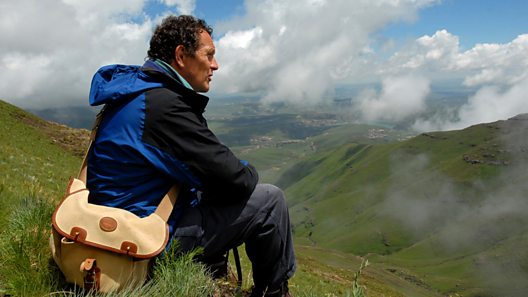Bristol is widely seen as the ‘Hollywood’ of wildlife film-making and is famously home to the BBC’s Natural History Unit, formerly established in the city in 1957. The University of Bristol Library’s Special Collections has embarked on a 2 year project to preserve and promote the mixed-media ‘Wildfilm’ archive, supported by funding from the Wellcome Trust.
 |
| An example draft shooting script for the first episode of ‘The Living Planet’ (1984), working title ‘Planet Earth’, later re-used in the 2006 BBC series! [G. Lever] |
I am the Project Archivist working to catalogue and re-package the material, making it available to search online and access in person at the Special Collections reading room. There are treatments, post-production scripts, dubbing cue sheets, filming trip planning, photographs, research and correspondence – documenting a given programme from conception to broadcast – as well as audience research reports, publicity and press packs.
 |
| A Radio Times cover from 1962 featuring Peter Scott for the ‘Look’ series [G. Lever] |
A substantial part of the collection is audio-visual, including several hundred reels of 16mm film footage. Among the cans are films produced by Survival Anglia, the BBC, and renowned film-makers Niko Tinbergen (1907-1988) and Eric Ashby MBE (1918-2003). The archive also contains sound recordings, radio broadcasts and audio from talks and festivals. In Digi-Beta format there is a selection of the 150 most important wildlife films selected by BBC producer Christopher Parsons (1932-2002) and a VHS library collected by Jeffery Boswall (1931-2012), another BBC producer whose papers are also in the archive.
 |
| An example of 16mm film cans in the collection [G. Lever] |
As evidence of method and technique there are two of the home-made sound-proof boxes made by Eric Ashby, enabling him to capture intimate footage of badgers and foxes in their natural state of behaviour. For further interpretation there are some unusual supplementary objects such as the penguin flipper, skulls and skin collected during filming in South America for ‘The Private Life of the Jackass Penguin’ (1973).
 |
| Eric Ashby’s home-made box for insulating sound made by camera equipment [Helen Lindsay] |
 |
| A dubbing cue sheet for an episode of the BBC’s ‘The World About Us’ [G. Lever] |
It’s an incredibly exciting project to be involved in. I’m working alongside Peter Bassett, a producer with the BBC Natural History Unit who has acted as guardian and advocate for the collection and is a font of knowledge on the history of wildlife film making. Nigel Bryant, Audiovisual Digitisation Officer will join the project for a year to produce lossless digital preservation copies of selected material, enhancing the accessibility of audio-visual media in the collection and protecting the longevity of these fragile, obsolete formats. We’re confident the archive offers significant research value to a variety of disciplines and interests – from the history of media and television to environmental studies, anthropology, history, philosophy and music.
Consistently these films bear witness to changes in the natural world leading us towards today’s climate crisis, educating us about the animal kingdom and the landscape we inhabit, reminding us of our responsibility to protect it.
 |
| The artist Jody’s mural of Greta Thunberg on the side of the Tobacco Factory, North Street, Bristol [G. Lever] |
The climate activist Greta Thunberg recently guest edited an episode of the Today programme on BBC Radio 4. During a Skype interview with Sir David Attenborough, she said:
“When I was younger, when I was maybe 9-10 years old, the thing that made me open my eyes for what was happening with the environment was films and documentaries about the natural world, and what was going on, so thank you for that, because that was what made me decide to do something about it.”
The archive has its foundations in a project led by another Bristol based organisation, Wildscreen, founded in 1982 by Christopher Parsons. Wildscreen hosts an internationally renowned biennial festival on wildlife film (the 20th anniversary festival will be held later this year, 19-23 October 2020) and supports a variety of conservation organisations. It launched ‘WildFilmHistory: 100 years of wildlife film making’ in 2008, a Heritage Lottery funded project that led to a collection of material which now forms part of the ‘Wildfilm’ archive.
Another compelling aspect of the collection is a series of oral history films made by the WildFilmHistory project, spanning all facets of film-making from producers and cameramen to composers and narrators. The interviews capture both the professional and personal alliance between subject and interviewer, enabling discussion to draw out the working relationships behind the creation of pivotal series such as the BBC’s ‘Look’ (1955-1969) and ITV’s ‘Survival’ (1961-2001).
The content of interviews ranges from anecdotal to technical, covering the logistical challenges of filming in remote places, photographic technique, reliability of equipment, battling physical elements, ingenious ways of tackling technological limitations and reflecting on moments of fortune and failure.
It is a renowned ambition of natural history film-making to capture a rare species or behaviour on camera for the first time; paperwork in the archive documents how this is attempted and achieved, and the role narrative construction may have to play in documentary film.
In a recent speech at the World Economic Forum, Sir David Attenborough said:
“When I made my first television programmes most audiences had never even seen a pangolin – indeed few pangolin had ever seen a TV camera!”
There has been an astonishing level of cultural and technological change since the programme, ‘Zoo Quest for a Dragon’ was broadcast in 1956 on the BBC – then one channel with national coverage only recently extending beyond London and Birmingham. In his published diaries for the Zoo Quest series, ‘Adventures of a Young Naturalist’, Attenborough recollects the obstacles involved in locating species unique to regions of Guyana, Indonesia and Paraguay. Through such programmes viewers gained their first glimpse of far flung parts of the world, now increasingly accessible with the growth of air travel and the tourism industry.
Improvements in technology allow viewers to observe the animal kingdom from new perspectives. The archive spans an era during which television has evolved from black and white to regular colour broadcasting in the late 1960s, and the invention of cinematic IMAX presentation to home based on-demand UHD (Ultra High Definition) 4KTV offered by streaming services today. In the same speech, Attenborough says:
“The audience for that first series, 60 years ago, was restricted to a few million viewers… My next series will go instantly to hundreds of millions of people in almost every country on Earth via Netflix”.
As well as the BBC Natural History Unit, the archive contains material for Survival Anglia, Granada, Partridge Films and the RSPB Film Unit, and international networks like the Australian Broadcasting Corporation and TVNZ.
There is a slim body of literature and theory on the history of wildlife film, but within the archive there is a unique collection of studies and published papers by academics tapping into this potential. Two excellent books are ‘Wildlife Films’ by Derek Bousé (University of Pennsylvania Press, 2000) and ‘BBC Wildlife Documentaries in the Age of Attenborough’ by Jean-Baptiste Gouyon (Palgrave Macmillan, 2019).
 |
| Some material relating to Granada’s ‘Zoo Time’ series (1956-1968) [G. Lever] |
All this material is being described in a detailed catalogue, capturing key words such as species and filming locations to ensure relevant content can be found by anyone with an interest in the archive. When complete the full catalogue will be launched on the Special Collections webpage in the summer of 2021.
—————————–
This blog was written by Georgina Lever, a project archivist from the Wildfilm Special Collections at the University of Bristol. This blog has been reposted with kind permission from the Centre for Environmental Humanities. View the original blog.









